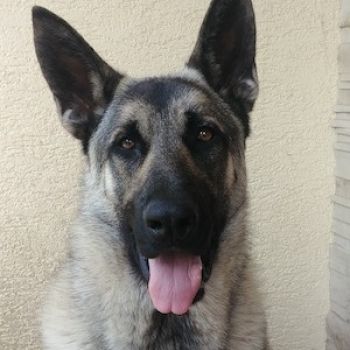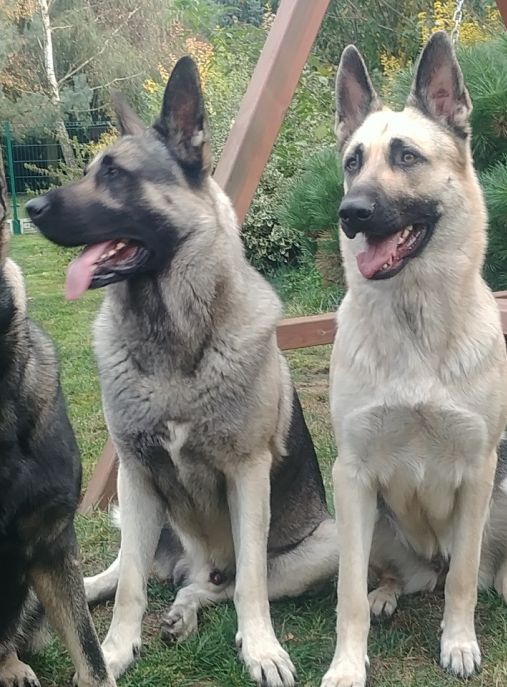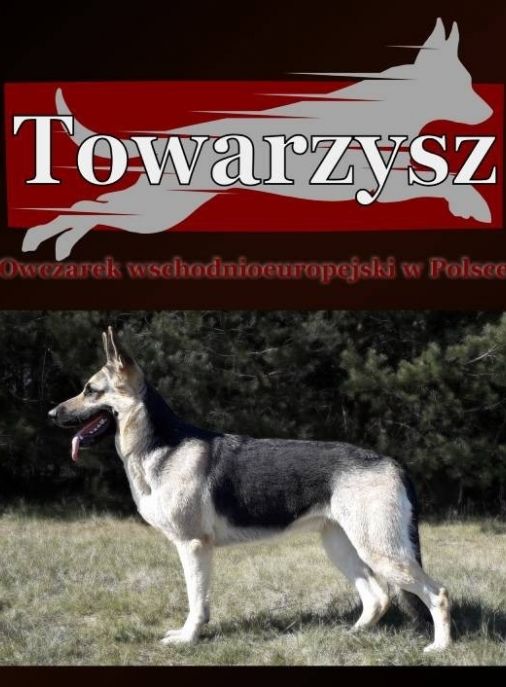The East European Shepherd, also known as VEO (Vostochno Evropeiskaya Ovcharka), is a large and powerful dog breed that originated in the former Soviet Union. This breed is highly regarded for its exceptional working abilities, loyalty, and protective nature. With a strong and muscular build, the East European Shepherd is well-suited for various tasks, including guarding, herding, and search and rescue operations.
The history of the East European Shepherd dates back to the early 20th century when the Soviet Union recognized the need for a versatile and reliable working dog. The breed was developed by crossing German Shepherds with local Russian breeds, such as the Caucasian Shepherd and Central Asian Shepherd. The goal was to create a dog that possessed the intelligence and trainability of the German Shepherd while being better adapted to the harsh climate and demanding working conditions of the Soviet Union.
According to the FCI (Fédération Cynologique Internationale) typology, the East European Shepherd belongs to Group 1: Sheepdogs and Cattle Dogs (except Swiss Cattle Dogs). This group includes various herding breeds that excel in protecting and managing livestock. The East European Shepherd is specifically classified under Section 1: Sheepdogs. This section comprises breeds that are primarily used for herding and guarding sheep.
The dogs of the East European Shepherd breed are primarily intended for working purposes. They are highly valued by law enforcement agencies, military units, and search and rescue teams for their exceptional tracking, guarding, and obedience skills. Additionally, their protective nature and loyalty make them excellent family companions and guard dogs.
In terms of physical characteristics, the East European Shepherd is a large and robust breed. Males typically weigh between 80 to 110 pounds (36 to 50 kg), while females weigh slightly less, ranging from 70 to 95 pounds (32 to 43 kg). The height at the shoulder for males is around 26 to 28 inches (66 to 71 cm), and for females, it is slightly smaller, ranging from 24 to 26 inches (61 to 66 cm).
The life expectancy of the East European Shepherd is generally around 10 to 12 years. However, with proper care, nutrition, and regular exercise, some individuals have been known to live even longer. This breed requires a high level of physical activity and mental stimulation to thrive. Daily exercise, such as long walks, jogging, or playing fetch, is essential to keep them happy and healthy.
One interesting fact about the East European Shepherd is its exceptional adaptability to various climates. This breed can withstand extreme temperatures, whether it be the freezing cold of Siberia or the scorching heat of Central Asia. Their thick double coat provides insulation and protection from harsh weather conditions.
Another notable characteristic of the East European Shepherd is its strong protective instinct. They are naturally wary of strangers and will act as excellent guard dogs. However, early socialization and proper training are crucial to ensure they can differentiate between genuine threats and harmless situations.
In conclusion, the East European Shepherd, or VEO, is a remarkable breed that combines intelligence, loyalty, and working abilities. With a rich history and a strong presence in various working fields, this breed continues to impress with its versatility and adaptability. Whether as a working dog or a loyal family companion, the East European Shepherd is a breed that excels in both roles.
The East European Shepherd, also known as VEO (Vostochno Evropeiskaya Ovcharka), is a remarkable breed of dog that possesses a unique character and temperament. These dogs are known for their loyalty, intelligence, and protective nature, making them excellent companions and working dogs.
One of the defining characteristics of the East European Shepherd is their strong sense of loyalty towards their family. They form deep bonds with their owners and are always eager to please. This loyalty extends to their protective instincts, as they are naturally inclined to guard and protect their loved ones. This makes them excellent watchdogs and guard dogs, as they are always alert and ready to defend their territory.
In terms of behavior, East European Shepherds are known to be confident and self-assured. They have a calm and composed demeanor, which allows them to handle stressful situations with ease. However, they can also be quite reserved and cautious around strangers, which is why early socialization is crucial for this breed. Proper socialization from an early age will help them develop into well-rounded dogs that are comfortable in various environments and with different people.
When it comes to raising and training an East European Shepherd, consistency and firmness are key. These dogs are highly intelligent and have a strong desire to please their owners, which makes them relatively easy to train. However, they can also be independent and stubborn at times, so it's important to establish yourself as the pack leader from the beginning. Positive reinforcement techniques, such as treats and praise, work best with this breed, as they respond well to rewards and encouragement.
Exercise is another important aspect of raising an East European Shepherd. These dogs have a high energy level and require regular physical and mental stimulation to stay happy and healthy. Daily walks, playtime, and training sessions are essential to keep them mentally and physically engaged. They also thrive in environments where they have a job to do, such as obedience training, agility, or even search and rescue work.
In conclusion, the East European Shepherd is a breed that possesses a unique character and temperament. Their loyalty, intelligence, and protective nature make them excellent companions and working dogs. With proper training, socialization, and exercise, these dogs can become well-rounded and obedient pets that bring joy and security to their families.
The East European Shepherd, also known as VEO (Vostochno Evropeiskaya Ovcharka), is a magnificent breed that requires specific care to ensure their well-being and happiness. These dogs are known for their intelligence, loyalty, and protective nature, making them excellent companions and working dogs. Here are some tips on how to care for East European Shepherds:
1. Exercise: East European Shepherds are active dogs that require regular exercise to maintain their physical and mental health. Daily walks, playtime, and engaging activities such as obedience training or agility exercises are essential. Aim for at least 1-2 hours of exercise each day to keep them stimulated and prevent boredom.
2. Socialization: Early socialization is crucial for East European Shepherds to develop into well-rounded dogs. Introduce them to various people, animals, and environments from a young age. This helps them become more confident, adaptable, and less prone to aggression or fearfulness. Enroll them in puppy classes or obedience training to enhance their social skills.
3. Mental Stimulation: These intelligent dogs thrive on mental challenges. Provide them with interactive toys, puzzle games, and training sessions to keep their minds sharp. Engaging in activities like scent work or obedience trials can also provide mental stimulation while strengthening the bond between you and your dog.
4. Grooming: East European Shepherds have a thick double coat that requires regular grooming. Brush their fur at least once or twice a week to prevent matting and remove loose hair. During shedding seasons, daily brushing may be necessary. Bathing should be done when necessary, using a dog-specific shampoo to maintain their coat's natural oils. Trim their nails regularly and check their ears for any signs of infection.
5. Proper Diet: Provide a balanced and nutritious diet to support your East European Shepherd's overall health. Consult with a veterinarian to determine the appropriate portion sizes and choose high-quality dog food that meets their specific needs. Avoid overfeeding, as these dogs can be prone to weight gain, which can lead to various health issues.
6. Training and Leadership: East European Shepherds are highly trainable and eager to please their owners. Consistent and positive reinforcement-based training methods work best for this breed. Establish yourself as a firm but fair leader, using rewards and praise to motivate them. Avoid harsh training techniques or punishment, as it can lead to fear or aggression.
7. Health Care: Regular veterinary check-ups are essential to monitor your East European Shepherd's health. Vaccinations, parasite prevention, and dental care should be part of their routine. Additionally, be aware of breed-specific health concerns such as hip dysplasia, elbow dysplasia, and bloat. Early detection and proper management can help ensure a long and healthy life for your dog.
8. Avoid Overprotection: While East European Shepherds are naturally protective, it's important to avoid overprotective behavior. Proper socialization and training can help them distinguish between genuine threats and everyday situations. Encourage positive interactions with strangers and other animals to prevent aggression or fear-based reactions.
9. Provide a Safe Environment: East European Shepherds need a secure and spacious environment to thrive. A securely fenced yard is essential to prevent them from wandering off or getting into trouble. Ensure they have access to shade, fresh water, and a comfortable resting area. Avoid leaving them alone for extended periods, as they thrive on human companionship.
10. Love and Affection: Lastly, East European Shepherds are incredibly loyal and devoted dogs. Shower them with love, attention, and affection to strengthen the bond between you. Spend quality time together, engage in activities they enjoy, and provide plenty of praise and physical affection to keep them happy and content.
Remember, each dog is unique, and individual care requirements may vary. It's crucial to understand your East European Shepherd's specific needs and adjust your care accordingly. With proper care, training, and love, your East European Shepherd will be a cherished companion for many years to come.
The East European Shepherd, also known as VEO (Vostochno Evropeiskaya Ovcharka), is a magnificent breed that boasts a variety of colors, each adding to its unique charm and appeal. While the breed standard allows for a range of colors, there is one common color that is often associated with these majestic dogs.
The most common color seen in East European Shepherds is a striking combination of black and tan. The majority of these dogs have a predominantly black coat with tan markings on specific areas of their body. The black coloration is deep and rich, giving the dog an air of strength and power. It covers most of the body, including the back, sides, and tail.
The tan markings, on the other hand, provide a beautiful contrast against the black background. These markings are typically found on the dog's face, chest, legs, and eyebrows. The tan color is usually lighter and can range from a warm caramel shade to a lighter sandy hue. These markings often accentuate the dog's facial features, making their expressions more expressive and captivating.
In some cases, the tan markings may also extend to the underside of the dog, creating a stunning visual effect when the dog is in motion. This color combination gives the East European Shepherd a regal and noble appearance, making them stand out in a crowd.
It is worth noting that while black and tan is the most common color, East European Shepherds can also come in other color variations. These include solid black, solid tan, sable, and even bi-color combinations. However, it is the black and tan coat that is most frequently associated with this breed.
The coat of the East European Shepherd is dense, thick, and weather-resistant, providing excellent protection against harsh climates. This double coat consists of a soft undercoat and a longer, coarser outer coat. The black and tan coloration adds depth and dimension to the coat, making it visually appealing and adding to the overall allure of the breed.
In conclusion, the common color of East European Shepherds, or VEO dogs, is a striking combination of black and tan. This coloration, with its deep black coat and contrasting tan markings, enhances the breed's majestic appearance and adds to its regal charm. Whether they are standing tall or in motion, these dogs are a sight to behold, with their captivating coloration and powerful presence.
The East European Shepherd, also known as VEO (Vostochno Evropeiskaya Ovcharka), is a robust and hardy breed originating from the former Soviet Union. These dogs were primarily bred for their working abilities, including herding, guarding, and protecting livestock. With their strong physique and protective nature, they make excellent companions and working dogs. However, like any other breed, they are prone to certain health issues that require proper care and attention.
One of the most common health concerns in East European Shepherds is hip dysplasia. This condition occurs when the hip joint doesn't develop properly, leading to discomfort, lameness, and eventually arthritis. To minimize the risk of hip dysplasia, it is crucial to obtain puppies from reputable breeders who conduct health screenings on their breeding stock. Regular exercise, a balanced diet, and maintaining a healthy weight can also help reduce the chances of developing this condition.
Another prevalent health issue in VEO dogs is degenerative myelopathy (DM). DM is a progressive neurological disorder that affects the spinal cord, leading to hind limb weakness and paralysis. While there is no cure for DM, early detection through genetic testing can help breeders avoid passing on the disease to future generations. Regular veterinary check-ups and a supportive environment can improve the quality of life for dogs affected by DM.
Like many large breeds, East European Shepherds are also prone to bloat or gastric dilatation-volvulus (GDV). This life-threatening condition occurs when the stomach fills with gas and twists on itself, cutting off blood supply. To prevent bloat, it is advisable to feed dogs smaller, frequent meals, avoid exercise immediately after meals, and use elevated feeding bowls. If you notice symptoms such as restlessness, unproductive retching, or a distended abdomen, seek immediate veterinary assistance.
Additionally, VEO dogs may be susceptible to allergies, particularly food allergies and atopic dermatitis. Food allergies can manifest as gastrointestinal issues or skin problems, while atopic dermatitis leads to itching, redness, and recurrent skin infections. Identifying and eliminating the allergen from the dog's diet or environment is crucial in managing these conditions. Consultation with a veterinarian and potentially conducting allergy tests can help determine the best course of action.
To ensure the overall health and well-being of East European Shepherds, regular veterinary check-ups, vaccinations, and parasite prevention are essential. Maintaining a balanced diet with high-quality dog food, appropriate for their age and activity level, is crucial. Regular exercise, mental stimulation, and socialization are also vital for their physical and mental health.
Grooming requirements for VEO dogs are relatively low. They have a thick double coat that sheds seasonally, requiring regular brushing to remove loose hair and prevent matting. Bathing should be done as needed, using dog-specific shampoos to avoid skin irritation. Routine dental care, including regular teeth brushing and dental check-ups, is essential to prevent periodontal disease.
In conclusion, while the East European Shepherd is generally a healthy breed, they are prone to certain health issues like hip dysplasia, degenerative myelopathy, bloat, and allergies. Responsible breeding practices, early detection, and proper care can help minimize the impact of these conditions. Regular veterinary care, a balanced diet, exercise, and grooming are vital for maintaining the health and happiness of these magnificent dogs.
The East European Shepherd, also known as VEO (Vostochno Evropeiskaya Ovcharka), is a large and powerful breed of dog originating from Eastern Europe. These dogs have specific nutritional needs to support their active lifestyle and maintain optimal health. Proper feeding is essential to ensure their overall well-being and longevity.
When it comes to feeding a VEO, it is important to provide a balanced diet that meets their nutritional requirements. Here are some guidelines and advice on how to feed and what to avoid when it comes to the nutrition of East European Shepherds:
1. High-Quality Protein: VEO dogs are active and muscular, requiring a diet rich in high-quality protein sources. Look for dog food that lists meat or meat meals as the primary ingredient. Protein helps in muscle development, repair, and overall growth.
2. Balanced Diet: Ensure that the dog food you choose provides a balanced mix of protein, carbohydrates, and fats. A well-balanced diet will provide the necessary energy for their active lifestyle while supporting their overall health.
3. Essential Fatty Acids: Omega-3 and Omega-6 fatty acids are crucial for maintaining healthy skin and coat. Look for dog food that contains fish oil, flaxseed, or other sources of these essential fatty acids.
4. Adequate Calories: VEO dogs are known for their high energy levels. They require a diet that provides enough calories to sustain their activity levels. However, it is important to monitor their weight and adjust the portion sizes accordingly to prevent obesity.
5. Avoid Fillers and By-Products: Avoid dog foods that contain excessive fillers, artificial additives, and by-products. These ingredients offer little nutritional value and can lead to digestive issues or allergies in some dogs.
6. Regular Feeding Schedule: Establish a regular feeding schedule for your VEO dog. Divide their daily food intake into two or three meals to prevent overeating and aid digestion.
7. Fresh Water: Always provide fresh and clean water for your VEO dog. Hydration is essential for their overall health and well-being.
8. Avoid Overfeeding: While VEO dogs have a hearty appetite, it is important to avoid overfeeding. Obesity can lead to various health issues, including joint problems and decreased lifespan. Monitor their weight and adjust portion sizes accordingly.
9. Avoid Table Scraps: It is best to avoid feeding your VEO dog table scraps or human food. Many human foods can be toxic to dogs or cause digestive upset. Stick to a high-quality dog food that meets their nutritional needs.
10. Regular Vet Check-ups: Regular veterinary check-ups are crucial to monitor your VEO dog's overall health and nutritional needs. Your vet can provide specific advice tailored to your dog's individual requirements.
Remember, every dog is unique, and their nutritional needs may vary. It is always recommended to consult with a veterinarian or a professional dog nutritionist to ensure you are providing the best possible diet for your East European Shepherd.





